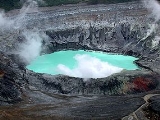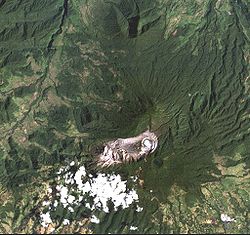
Poás Volcano
Encyclopedia
The Poás Volcano, in Spanish Volcán Poás, is an active stratovolcano
in central Costa Rica
. Poás has erupted 39 times since 1828.
of almost 0; consequently, it supports little or no aquatic life. The bottom of this lake is covered with a layer of liquid sulphur. Acid gases create a phenomenon of acid rain
and acid fog, causing damage to surrounding ecosystems and often irritation of eyes and lungs.
Lake Botos, the southern lake, fills an inactive crater, which last erupted in 7500BC
. It is cold and clear, and is surrounded by a cloud forest
located within the Poás Volcano National Park
.
 Poás was near the epicenter of a 6.1-magnitude earthquake
Poás was near the epicenter of a 6.1-magnitude earthquake
in January 2009 that killed at least forty people and affected Fraijanes, Vara Blanca
, Cinchona (the most affected area), the capital San José
, and the Central Valley region of Costa Rica.
It also has had eruptive activity in 2009 involving minor phreatic eruption
s and landslide
s within the northern active crater. Poás eruptions often include geyser
-like ejections of crater-lake water.
Stratovolcano
A stratovolcano, also known as a composite volcano, is a tall, conical volcano built up by many layers of hardened lava, tephra, pumice, and volcanic ash. Unlike shield volcanoes, stratovolcanoes are characterized by a steep profile and periodic, explosive eruptions...
in central Costa Rica
Costa Rica
Costa Rica , officially the Republic of Costa Rica is a multilingual, multiethnic and multicultural country in Central America, bordered by Nicaragua to the north, Panama to the southeast, the Pacific Ocean to the west and the Caribbean Sea to the east....
. Poás has erupted 39 times since 1828.
Crater lakes
There are two crater lakes near its summit. The northern lake is known as the Laguna Caliente and is located at a height of 2,300 m in an approximately 1.7 km wide and 290 – 300 m deep crater. It is one of the world's most acidic lakes. Acidity of the lake varies after rain and changes in volcanic activity, sometimes reaching a pHPH
In chemistry, pH is a measure of the acidity or basicity of an aqueous solution. Pure water is said to be neutral, with a pH close to 7.0 at . Solutions with a pH less than 7 are said to be acidic and solutions with a pH greater than 7 are basic or alkaline...
of almost 0; consequently, it supports little or no aquatic life. The bottom of this lake is covered with a layer of liquid sulphur. Acid gases create a phenomenon of acid rain
Acid rain
Acid rain is a rain or any other form of precipitation that is unusually acidic, meaning that it possesses elevated levels of hydrogen ions . It can have harmful effects on plants, aquatic animals, and infrastructure. Acid rain is caused by emissions of carbon dioxide, sulfur dioxide and nitrogen...
and acid fog, causing damage to surrounding ecosystems and often irritation of eyes and lungs.
Lake Botos, the southern lake, fills an inactive crater, which last erupted in 7500BC
Anno Domini
and Before Christ are designations used to label or number years used with the Julian and Gregorian calendars....
. It is cold and clear, and is surrounded by a cloud forest
Cloud forest
A cloud forest, also called a fog forest, is a generally tropical or subtropical evergreen montane moist forest characterized by a persistent, frequent or seasonal low-level cloud cover, usually at the canopy level. Cloud forests often exhibit an abundance of mosses covering the ground and...
located within the Poás Volcano National Park
Poás Volcano National Park
Poás Volcano National Park, in Spanish , is a National Park that covers an area of approximately ; the summit is . One of the attractive features about Poás is that you can get all the way to the edge of the crater...
.
Eruptive history

2009 Costa Rica earthquake
The 2009 Costa Rica earthquake , occurred at 1:21:34 pm local time on January 8, 2009. The epicenter of the 6.1 Mw earthquake was in northern Costa Rica, north-northwest of San José...
in January 2009 that killed at least forty people and affected Fraijanes, Vara Blanca
Vara Blanca
Vara Blanca is a small village located between Poas Volcano and Barva Volcano in Costa Rica. It is an important cross-road location for all major traffic connecting the northern parts of Costa Rica especially the Sarapiqui River delta area with the major population area of the San Jose Central Valley...
, Cinchona (the most affected area), the capital San José
San José, Costa Rica
San José is the capital and largest city of Costa Rica. Located in the Central Valley, San José is the seat of national government, the focal point of political and economic activity, and the major transportation hub of this Central American nation.Founded in 1738 by order of Cabildo de León, San...
, and the Central Valley region of Costa Rica.
It also has had eruptive activity in 2009 involving minor phreatic eruption
Phreatic eruption
A phreatic eruption, also called a phreatic explosion or ultravulcanian eruption, occurs when rising magma makes contact with ground or surface water. The extreme temperature of the magma causes near-instantaneous evaporation to steam, resulting in an explosion of steam, water, ash, rock, and...
s and landslide
Landslide
A landslide or landslip is a geological phenomenon which includes a wide range of ground movement, such as rockfalls, deep failure of slopes and shallow debris flows, which can occur in offshore, coastal and onshore environments...
s within the northern active crater. Poás eruptions often include geyser
Geyser
A geyser is a spring characterized by intermittent discharge of water ejected turbulently and accompanied by a vapour phase . The word geyser comes from Geysir, the name of an erupting spring at Haukadalur, Iceland; that name, in turn, comes from the Icelandic verb geysa, "to gush", the verb...
-like ejections of crater-lake water.

